2006 DODGE RAM SRT-10 air condition
[x] Cancel search: air conditionPage 5155 of 5267

COUPLER-REFRIGERANT LINE
DESCRIPTION
Spring-lock type refrigerant line couplers (1 and 4) are
used to connect the A/C suction line (6) to the A/C
accumulator (5) and, the A/C accumulator and the A/C
liquid line to the A/C evaporator tubes (3). Secondary
retaining clips (2 and 7) are installed over the con-
nected couplers for added protection.
The spring-lock refrigerant line couplers require spe-
cial disconnect tools for disengaging the two coupler
halves.
OPERATION
The spring-lock type refrigerant line coupler is held
together by a garter spring (6) inside a circular cage
(7) on the male half of the fitting (1). When the two
coupler halves are connected, the flared end of the
female fitting (2) slips behind the garter spring inside
the cage on the male fitting. The garter spring and
cage prevent the flared end of the female fitting from
pulling out of the cage. Some applications use a con-
nection indicator ring (4) to help indicate when the two
coupler halves are fully connected.
Two O-rings (8) are used to seal the coupler connec-
tions. These O-rings are compatible with R-134a
refrigerant and must be replaced with O-rings made of
the same material.
A secondary retaining clip (3) is installed over the con-
nected coupler (5) for added protection.
REMOVAL
WARNING: Refer to the applicable warnings and cautions for this system before performing the following
operation (Refer to 24 - HEATING & AIR CONDITIONING/PLUMBING - WARNINGS) and (Refer to 24 - HEAT-
ING & AIR CONDITIONING/PLUMBING - CAUTIONS). Failure to follow the warnings and cautions could result
in possible personal injury or death.
Page 5156 of 5267
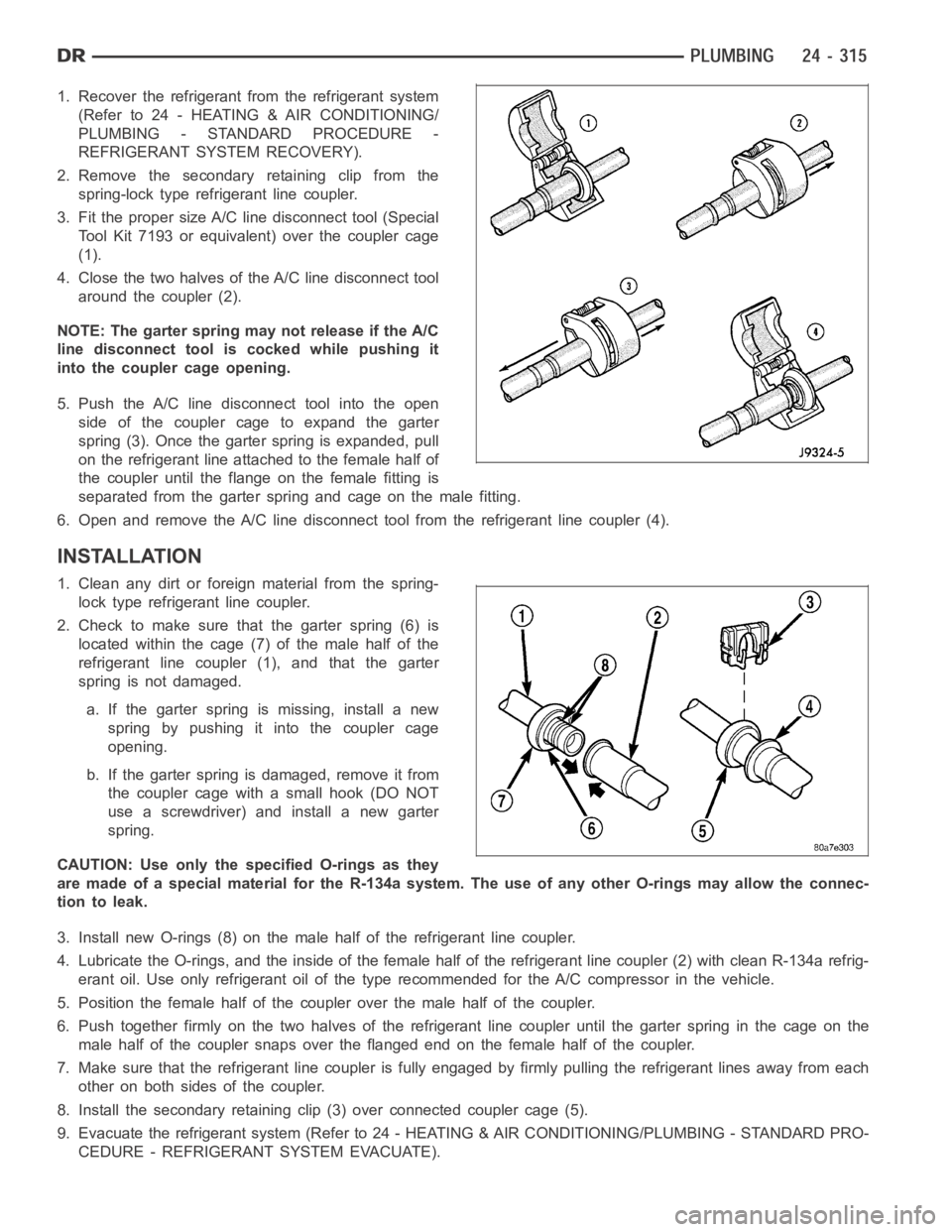
1. Recover the refrigerant from the refrigerant system
(Refer to 24 - HEATING & AIR CONDITIONING/
PLUMBING - STANDARD PROCEDURE -
REFRIGERANT SYSTEM RECOVERY).
2. Remove the secondary retaining clip from the
spring-lock type refrigerant line coupler.
3. Fit the proper size A/C line disconnect tool (Special
Tool Kit 7193 or equivalent) over the coupler cage
(1).
4. Close the two halves of the A/C line disconnect tool
around the coupler (2).
NOTE: The garter spring may not release if the A/C
line disconnect tool is cocked while pushing it
into the coupler cage opening.
5. Push the A/C line disconnect tool into the open
side of the coupler cage to expand the garter
spring (3). Once the garter spring is expanded, pull
on the refrigerant line attached to the female half of
the coupler until the flange on the female fitting is
separated from the garter spring and cage on the male fitting.
6. Open and remove the A/C line disconnect tool from the refrigerant line coupler (4).
INSTALLATION
1. Clean any dirt or foreign material from the spring-
lock type refrigerant line coupler.
2. Check to make sure that the garter spring (6) is
located within the cage (7) of the male half of the
refrigerant line coupler (1), and that the garter
spring is not damaged.
a. If the garter spring is missing, install a new
spring by pushing it into the coupler cage
opening.
b. If the garter spring is damaged, remove it from
the coupler cage with a small hook (DO NOT
use a screwdriver) and install a new garter
spring.
CAUTION: Use only the specified O-rings as they
are made of a special material for the R-134a system. The use of any other O-rings may allow the connec-
tion to leak.
3. Install new O-rings (8) on the male half of the refrigerant line coupler.
4. Lubricate the O-rings, and the inside of the female half of the refrigerant line coupler (2) with clean R-134a refrig-
erant oil. Use only refrigerant oil of the type recommended for the A/C compressor in the vehicle.
5. Position the female half of the coupler over the male half of the coupler.
6. Push together firmly on the two halves of the refrigerant line coupler until the garter spring in the cage on the
male half of the coupler snaps over the flanged end on the female half of the coupler.
7. Make sure that the refrigerant line coupler is fully engaged by firmly pulling the refrigerant lines away from each
other on both sides of the coupler.
8. Install the secondary retaining clip (3) over connected coupler cage (5).
9. Evacuate the refrigerant system (Refer to 24 - HEATING & AIR CONDITIONING/PLUMBING - STANDARD PRO-
CEDURE - REFRIGERANT SYSTEM EVACUATE).
Page 5157 of 5267

10. Charge the refrigerant system (Refer to 24 - HEATING & AIR CONDITIONING/PLUMBING - STANDARD PRO-
CEDURE - REFRIGERANT SYSTEM CHARGE).
Page 5158 of 5267
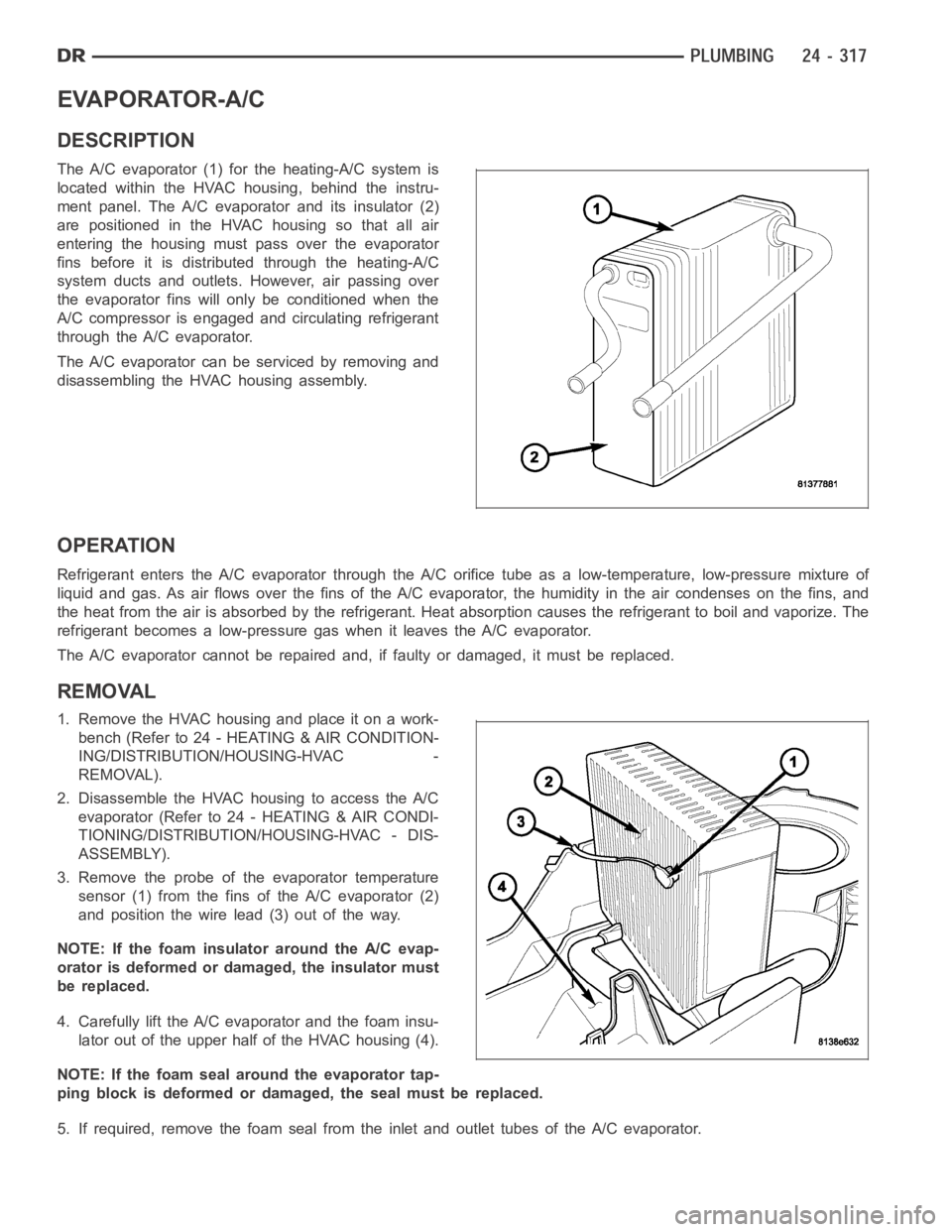
EVAPORATOR-A/C
DESCRIPTION
The A/C evaporator (1) for the heating-A/C system is
located within the HVAC housing, behind the instru-
ment panel. The A/C evaporator and its insulator (2)
are positioned in the HVAC housing so that all air
entering the housing must pass over the evaporator
fins before it is distributed through the heating-A/C
system ducts and outlets. However, air passing over
the evaporator fins will only be conditioned when the
A/C compressor is engaged and circulating refrigerant
through the A/C evaporator.
The A/C evaporator can be serviced by removing and
disassembling the HVAC housing assembly.
OPERATION
Refrigerant enters the A/C evaporator through the A/C orifice tube as a low-temperature, low-pressure mixture of
liquid and gas. As air flows over the fins of the A/C evaporator, the humidity in the air condenses on the fins, and
the heat from the air is absorbed by the refrigerant. Heat absorption causes the refrigerant to boil and vaporize. The
refrigerant becomes a low-pressure gas when it leaves the A/C evaporator.
The A/C evaporator cannot be repaired and, if faulty or damaged, it must be replaced.
REMOVAL
1. RemovetheHVAChousingandplaceitonawork-
bench (Refer to 24 - HEATING & AIR CONDITION-
ING/DISTRIBUTION/HOUSING-HVAC -
REMOVAL).
2. Disassemble the HVAC housing to access the A/C
evaporator (Refer to 24 - HEATING & AIR CONDI-
TIONING/DISTRIBUTION/HOUSING-HVAC - DIS-
ASSEMBLY).
3. Remove the probe of the evaporator temperature
sensor (1) from the fins of the A/C evaporator (2)
and position the wire lead (3) out of the way.
NOTE: If the foam insulator around the A/C evap-
orator is deformed or damaged, the insulator must
be replaced.
4. Carefully lift the A/C evaporator and the foam insu-
lator out of the upper half of the HVAC housing (4).
NOTE: If the foam seal around the evaporator tap-
ping block is deformed or damaged, the seal must be replaced.
5. If required, remove the foam seal from the inlet and outlet tubes of the A/Cevaporator.
Page 5159 of 5267
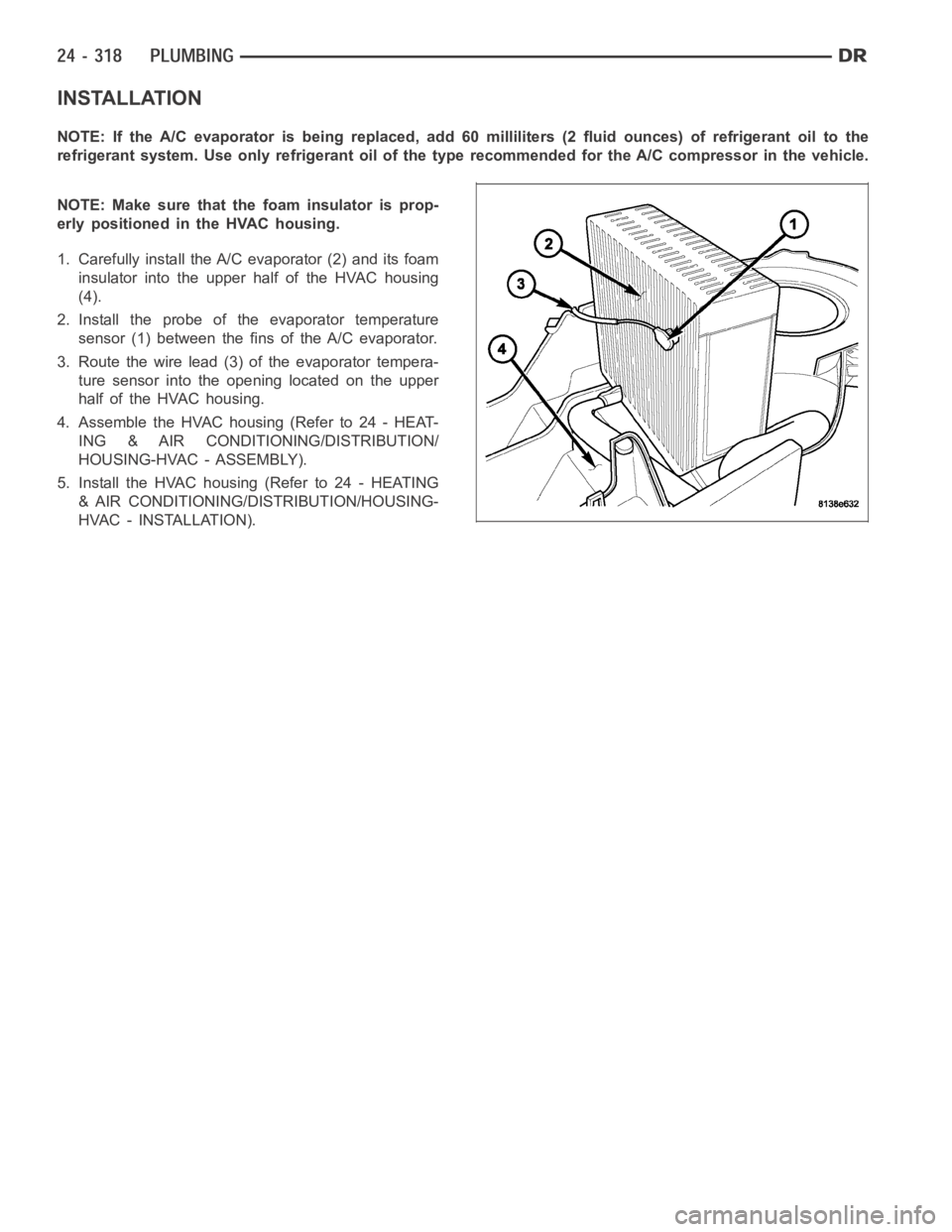
INSTALLATION
NOTE: If the A/C evaporator is being replaced, add 60 milliliters (2 fluid ounces) of refrigerant oil to the
refrigerant system. Use only refrigerant oil of the type recommended for the A/C compressor in the vehicle.
NOTE: Make sure that the foam insulator is prop-
erly positioned in the HVAC housing.
1. Carefully install the A/C evaporator (2) and its foam
insulator into the upper half of the HVAC housing
(4).
2. Install the probe of the evaporator temperature
sensor (1) between the fins of the A/C evaporator.
3. Route the wire lead (3) of the evaporator tempera-
ture sensor into the opening located on the upper
half of the HVAC housing.
4. Assemble the HVAC housing (Refer to 24 - HEAT-
ING & AIR CONDITIONING/DISTRIBUTION/
HOUSING-HVAC - ASSEMBLY).
5. Install the HVAC housing (Refer to 24 - HEATING
& AIR CONDITIONING/DISTRIBUTION/HOUSING-
HVAC - INSTALLATION).
Page 5160 of 5267
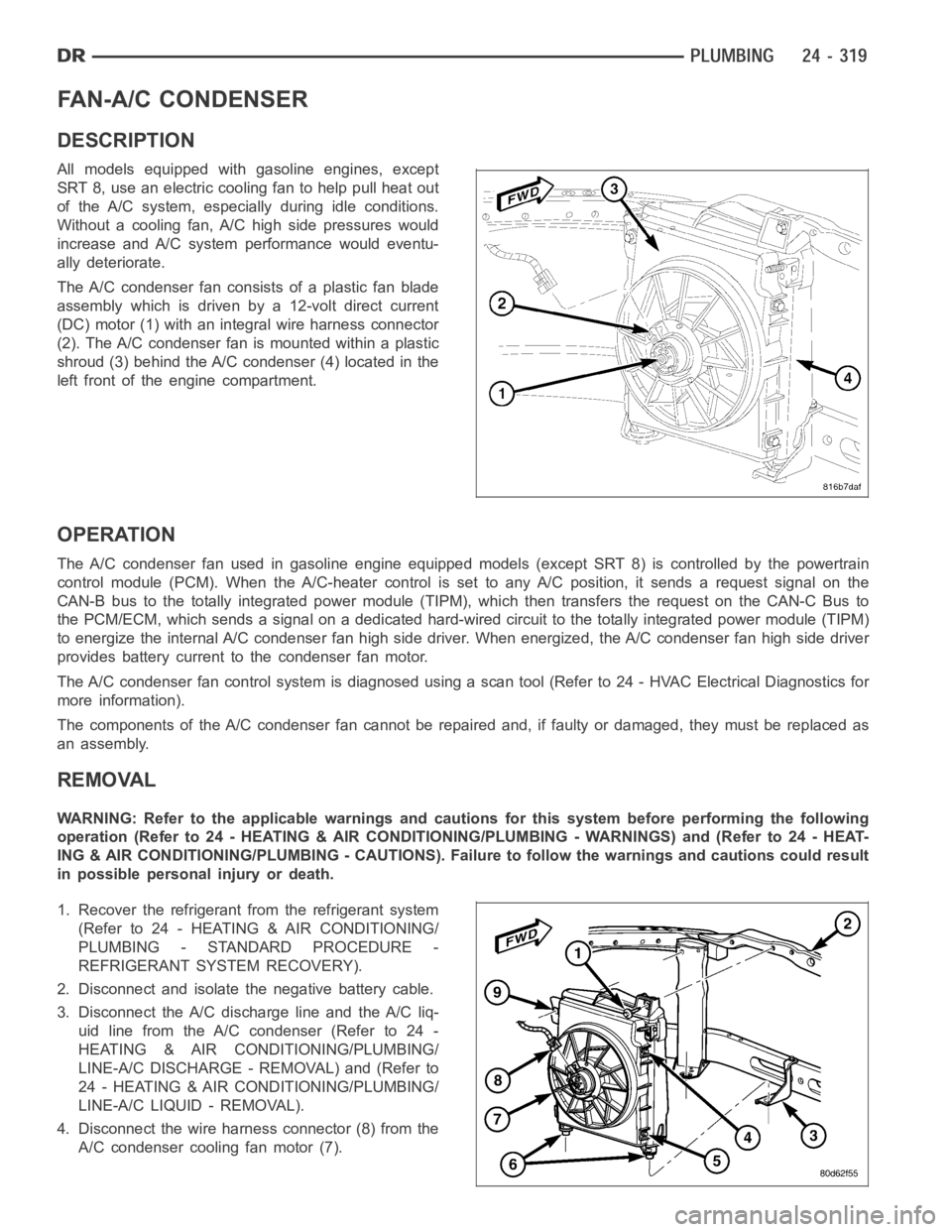
FAN-A/C CONDENSER
DESCRIPTION
All models equipped with gasoline engines, except
SRT 8, use an electric cooling fan to help pull heat out
of the A/C system, especially during idle conditions.
Without a cooling fan, A/C high side pressures would
increase and A/C system performance would eventu-
ally deteriorate.
The A/C condenser fan consists of a plastic fan blade
assembly which is driven by a 12-volt direct current
(DC) motor (1) with an integral wire harness connector
(2). The A/C condenser fan is mounted within a plastic
shroud (3) behind the A/C condenser (4) located in the
left front of the engine compartment.
OPERATION
The A/C condenser fan used in gasoline engine equipped models (except SRT 8) is controlled by the powertrain
control module (PCM). When the A/C-heater control is set to any A/C position, it sends a request signal on the
CAN-B bus to the totally integrated power module (TIPM), which then transfers the request on the CAN-C Bus to
the PCM/ECM, which sends a signal on a dedicated hard-wired circuit to the totally integrated power module (TIPM)
to energize the internal A/C condenser fan high side driver. When energized, the A/C condenser fan high side driver
provides battery current to the condenser fan motor.
The A/C condenser fan control system isdiagnosed using a scan tool (Refer to 24 - HVAC Electrical Diagnostics for
more information).
The components of the A/C condenser fan cannot be repaired and, if faulty ordamaged, they must be replaced as
an assembly.
REMOVAL
WARNING: Refer to the applicable warnings and cautions for this system before performing the following
operation (Refer to 24 - HEATING & AIR CONDITIONING/PLUMBING - WARNINGS) and (Refer to 24 - HEAT-
ING & AIR CONDITIONING/PLUMBING - CAUTIONS). Failure to follow the warnings and cautions could result
in possible personal injury or death.
1. Recover the refrigerant from the refrigerant system
(Refer to 24 - HEATING & AIR CONDITIONING/
PLUMBING - STANDARD PROCEDURE -
REFRIGERANT SYSTEM RECOVERY).
2. Disconnect and isolate the negative battery cable.
3. Disconnect the A/C discharge line and the A/C liq-
uidlinefromtheA/Ccondenser(Referto24-
HEATING & AIR CONDITIONING/PLUMBING/
LINE-A/C DISCHARGE - REMOVAL) and (Refer to
24 - HEATING & AIR CONDITIONING/PLUMBING/
LINE-A/C LIQUID - REMOVAL).
4. Disconnect the wire harness connector (8) from the
A/C condenser cooling fan motor (7).
Page 5161 of 5267
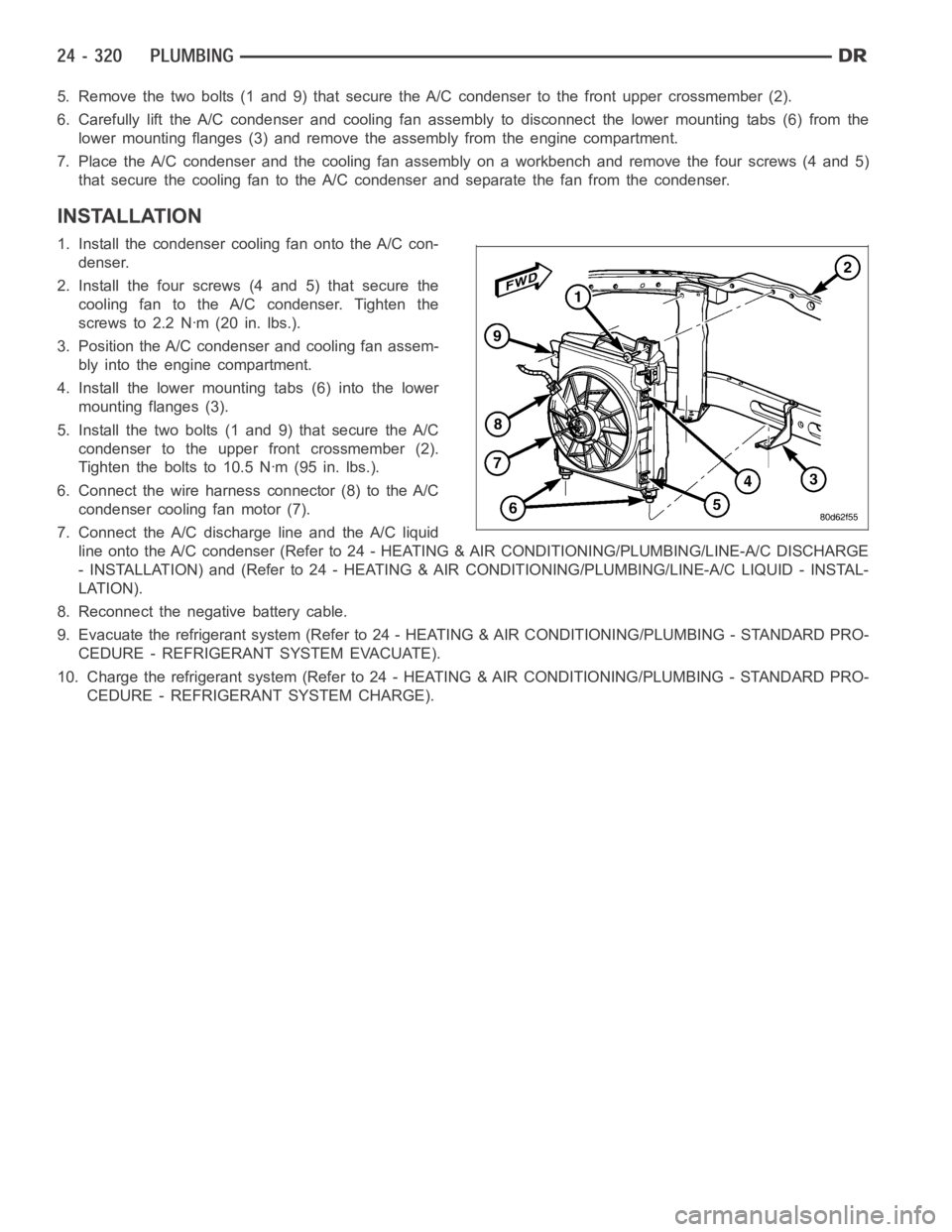
5. Remove the two bolts (1 and 9) that secure the A/C condenser to the front upper crossmember (2).
6. Carefully lift the A/C condenser and cooling fan assembly to disconnectthe lower mounting tabs (6) from the
lower mounting flanges (3) and remove the assembly from the engine compartment.
7. Place the A/C condenser and the cooling fan assembly on a workbench and remove the four screws (4 and 5)
that secure the cooling fan to the A/C condenser and separate the fan from the condenser.
INSTALLATION
1. Install the condenser cooling fan onto the A/C con-
denser.
2. Install the four screws (4 and 5) that secure the
cooling fan to the A/C condenser. Tighten the
screws to 2.2 Nꞏm (20 in. lbs.).
3. Position the A/C condenser and cooling fan assem-
bly into the engine compartment.
4. Install the lower mounting tabs (6) into the lower
mounting flanges (3).
5. Install the two bolts (1 and 9) that secure the A/C
condenser to the upper front crossmember (2).
Tighten the bolts to 10.5 Nꞏm (95 in. lbs.).
6. Connect the wire harness connector (8) to the A/C
condenser cooling fan motor (7).
7. Connect the A/C discharge line and the A/C liquid
line onto the A/C condenser (Refer to 24 - HEATING & AIR CONDITIONING/PLUMBING/LINE-A/C DISCHARGE
- INSTALLATION) and (Refer to 24 - HEATING & AIR CONDITIONING/PLUMBING/LINE-A/C LIQUID - INSTAL-
LATION).
8. Reconnect the negative battery cable.
9. Evacuate the refrigerant system (Refer to 24 - HEATING & AIR CONDITIONING/PLUMBING - STANDARD PRO-
CEDURE - REFRIGERANT SYSTEM EVACUATE).
10. Charge the refrigerant system (Refer to 24 - HEATING & AIR CONDITIONING/PLUMBING - STANDARD PRO-
CEDURE - REFRIGERANT SYSTEM CHARGE).
Page 5162 of 5267
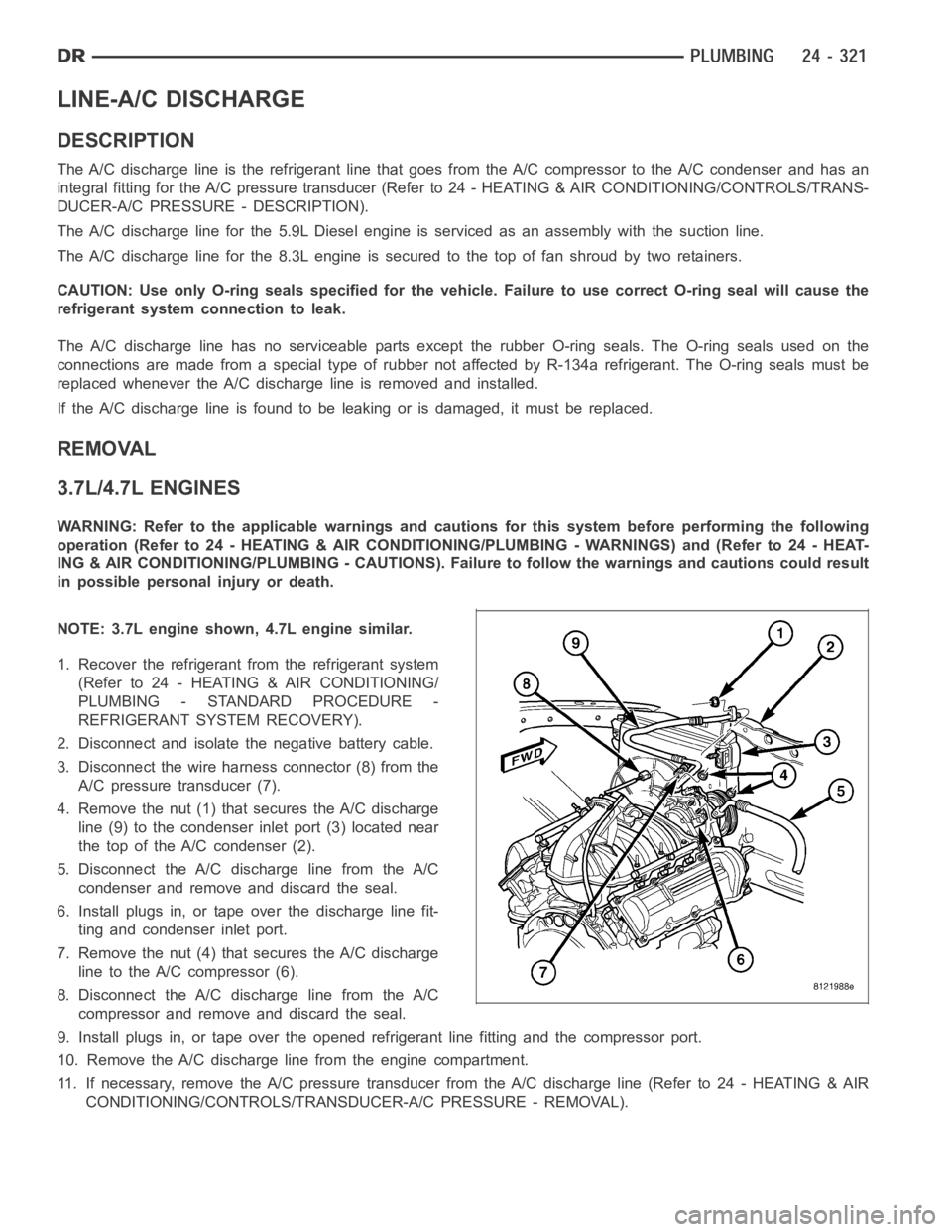
LINE-A/C DISCHARGE
DESCRIPTION
The A/C discharge line is the refrigerant line that goes from the A/C compressor to the A/C condenser and has an
integral fitting for the A/C pressure transducer (Refer to 24 - HEATING & AIR CONDITIONING/CONTROLS/TRANS-
DUCER-A/C PRESSURE - DESCRIPTION).
The A/C discharge line for the 5.9L Diesel engine is serviced as an assemblywith the suction line.
The A/C discharge line for the 8.3L engine is secured to the top of fan shroudby two retainers.
CAUTION: Use only O-ring seals specified for the vehicle. Failure to use correct O-ring seal will cause the
refrigerant system connection to leak.
The A/C discharge line has no serviceable parts except the rubber O-ring seals. The O-ring seals used on the
connections are made from a special type of rubber not affected by R-134a refrigerant. The O-ring seals must be
replaced whenever the A/C discharge line is removed and installed.
If the A/C discharge line is found to be leaking or is damaged, it must be replaced.
REMOVAL
3.7L/4.7L ENGINES
WARNING: Refer to the applicable warnings and cautions for this system before performing the following
operation (Refer to 24 - HEATING & AIR CONDITIONING/PLUMBING - WARNINGS) and (Refer to 24 - HEAT-
ING & AIR CONDITIONING/PLUMBING - CAUTIONS). Failure to follow the warnings and cautions could result
in possible personal injury or death.
NOTE: 3.7L engine shown, 4.7L engine similar.
1. Recover the refrigerant from the refrigerant system
(Refer to 24 - HEATING & AIR CONDITIONING/
PLUMBING - STANDARD PROCEDURE -
REFRIGERANT SYSTEM RECOVERY).
2. Disconnect and isolate the negative battery cable.
3. Disconnect the wire harness connector (8) from the
A/C pressure transducer (7).
4. Remove the nut (1) that secures the A/C discharge
line (9) to the condenser inlet port (3) located near
the top of the A/C condenser (2).
5. Disconnect the A/C discharge line from the A/C
condenser and remove and discard the seal.
6. Install plugs in, or tape over the discharge line fit-
ting and condenser inlet port.
7. Remove the nut (4) that secures the A/C discharge
line to the A/C compressor (6).
8. Disconnect the A/C discharge line from the A/C
compressor and remove and discard the seal.
9. Install plugs in, or tape over the opened refrigerant line fitting and the compressor port.
10. Remove the A/C discharge line from the engine compartment.
11. If necessary, remove the A/C pressure transducer from the A/C dischargeline(Referto24-HEATING&AIR
CONDITIONING/CONTROLS/TRANSDUCER-A/C PRESSURE - REMOVAL).